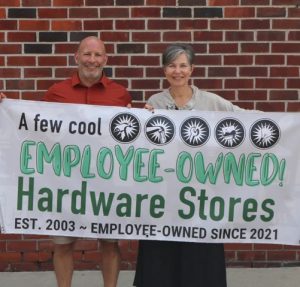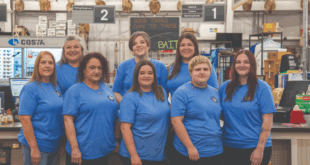Whether planned or unexpected, every business changes hands at some point, and most make a transition several times in the life of the operation. According to the PwC 2021 Family Business Survey, 50% of family businesses expect to increase the diversification of their business holdings in the next five years. While 96% of those businesses expect to grow, only 56% say there is family alignment on the direction the company should pursue and what growth looks like. Whether you are looking to exit the industry or dive in deeper, on the following pages, gain insights on business transition strategies from Gary Pittsford, chief valuation officer for Creative Planning. Plus, see the paths three retailers took for business transition to learn best practices for writing your next chapter.
Pass Down to Family

According to the 2020 U.S. Census, there are 73 million baby boomers in the country and by 2030, all baby boomers will have reached retirement age. In the next decade, home improvement operations run by baby boomers will see significant turnover, and one path they can embrace is handing the business to a family member.
This is the route Jack and Pam Stevenson of Stevenson’s Ace Hardware in Crawfordsville, Indiana, took last year when they sold the business to their son, Skylar Stevenson. The Stevensons were working on a three-year transition plan with Pittsford’s consulting company, but the timeline accelerated when the building the Stevensons leased went up for sale.
“An investor was looking seriously at buying the building, so I knew I either had to buy it myself or risk not knowing the future of the business,” Skylar says. “I worked closely with my banker at Live Oak Bank, and he advised me to not only buy the building but the business as well.”
Skylar chose a stock purchase of the business. The deal was closed in 95 days, much faster than the three-year plan the Stevensons had anticipated. Skylar says his parents assisted him with the financing to help the contract come together.
For the Stevensons, being transparent and open was key to the transition going smoothly.
“The more you can keep everyone informed that might someday be possibly involved or have a financial stake, even if it’s an unspoken stake at the time, the easier and smoother the process will be,” Skylar says.
Skylar also suggests clearly communicating with your customers about the transition process. The Stevensons used a local marketing company, which developed messaging the store used to communicate the transition. “Pass the Torch” communications were sent to customers through email, in-store signage and on social media.
“Even with all the messaging we did, there was still some confusion as to when my parents would actually step down from the store, so I think the more precise and clear you can be with customers, the better,” Skylar says.
Skylar says his wholesaler and the North American Hardware and Paint Association (NHPA) were also instrumental in the transition process. During the transition, Skylar was participating in NHPA’s Retail Management Certification Program, which was helpful in preparing him for ownership.
“Ace made it a smooth transition from my parents to myself,” Skylar says. “And all of my classmates in the NHPA program were really encouraging, checking in with me to see how the process was going.”
While the Stevenson’s transition worked out despite the tight timeline, Gary Pittsford, chief valuation officer for Creative Planning, recommends having an exit or transition plan in place three to five years before the owner plans on retiring. Making this plan early also protects the business in case of the unexpected death or disability of the owner. And planning shouldn’t stop with the owners. When the next generation comes into a leadership role, they should be thinking about their own succession plan, Pittsford says.
“Young retailers may not know who they will sell their business to in 20 years, but they should manage their business to make it financially strong,” Pittsford says. “From age 40 to 60, if retailers watch the financial side of their business and keep it strong, their succession plan will be easier to implement when they are ready to sell.”
One way to remain strong financially is to think outside the business. Pittsford says he has seen many business owners take any profits from the business and put them right back into the operation, which is a good business practice. But he also advises that some of those profits go toward investments outside the business, such as in the stock market, an IRA or 401(k), real estate or other assets.
“So many retailers take the money they make and buy more inventory or a truck or forklift or whatever they need
for the company. When they go to sell, all of their assets are tied up in the business,” he says. “When they want to sell, the owner has to get the highest dollar they can for the business in order to have enough money to live on in retirement. I recommend spending 10 to 20 years before retirement investing in the business, but also putting money in other areas so you’re diversified.”
Sell the Operation
With the boom in business in 2020 and 2021, many retailers are flush with cash and are looking to expand their retail footprints through acquisitions of existing home improvement businesses, which is great news for retailers wanting to sell.

Jorge Morgado and Mario Tedeschi, the owners of Allied Flooring, Paint and Design, went the acquisition route to grow their business and in the process kept another family-owned business running. The operation acquired Budget Cabinet Sales, a locally owned business adjacent to one of its stores in Agawam, Massachusetts. Allied Flooring, Paint and Design also has a location in East Longmeadow, Massachusetts.
“Each of our locations offers different types of products and services, allowing us to better serve our customers’ wide variety of needs,” Morgado says. “We always strive to be a one-stop shop for our customers.”
Staying true to that business model, the acquisition of Budget Cabinet Sales provided Allied customers with another layer of products and services. Morgado says he saw other retailers diving into kitchens and thought it would be a good fit for Allied.
“Because Mario is friends with the Lloyd family, who owned Budget Cabinet, we knew they would be selling the business. We started communicating with them about buying about nine months before the acquisition,” Morgado says. “We are always thinking of the one-stop shop environment, and this deal gives our customers at Agawam the ability to buy paint, flooring and cabinets in the same parking lot.”
As you walk through buying another business, Morgado recommends preparing for the emotional side of the deal. He says it’s helpful to acknowledge and honor the history of the company you’re buying. While their way of doing business may not align with your own, you can still respectfully appreciate what they’ve built and are willing to sell to you.
“Lean into the emotion, because the more you acknowledge what they built and the history around it, the more comfortable negotiations will be,” Morgado says. “We appreciated the model the Lloyd family built and assured them that we would continue that tradition of exceptional customer service.”
While Morgado says they were able to negotiate the company’s value with the Lloyds directly, Pittsford highly recommends going through a formal price evaluation. He says he has many owners who have decided that selling the business is the best option for their operation, but they have no idea what the business is worth. This is where valuation services are important to receive an accurate assessment of your company’s worth. It’s important to rely on consultants and companies that are well-versed in the home improvement industry who can offer a more accurate value based on nationwide averages and walk you through the selling process. NHPA recently launched valuation services as part of its Retail Marketplace platform. Retailers who are interested in selling can work with Pittsford to get an accurate valuation of their business and list their businesses for sale on the marketplace, which is advertised to retailers throughout the industry who are ready to buy.
“Sellers can take the valuation report to the buyers, and it really helps in the negotiation process,” Pittsford says. “Valuations are also useful for other needs, including determining value for probate if the owner dies or when owners get a divorce.”
Learn more about the NHPA Retail Marketplace and valuation services at YourNHPA.org/marketplace.
Form an ESOP

Another option is an employee stock ownership plan (ESOP), which is a tax-qualified retirement plan regulated by the federal government where the only investments are in that company’s stock. So, if the company does well and the value of its stock increases, the value of the ESOP and each employee’s share of the ESOP increases.
While forming an ESOP isn’t a good fit for all retailers because of the initial financial investment needed and the yearly costs, for larger companies, it can be another option that benefits their employees.
“In an ESOP, every employee in the company has a small piece of that retirement plan,” Pittsford says. “It’s really important that every employee works hard to make the company more valuable or more profitable, because if the company is more profitable, everybody in the company benefits.”
A Few Cool Hardware Stores became employee-owned in 2021 through the development of an ESOP. Gina Schaefer and her husband Marc Friedman started the company in 2003 with one store, and they have since grown the operation to 12 locations in the greater Washington, D.C., area. Schaefer says she started thinking about their exit strategy early thanks to the recommendations of friends, and she began looking into an ESOP in year 16 of the business.
“Small business owners don’t often spend enough time thinking about what their exit strategy is and how many options we actually have,” Schaefer says. “We love our neighborhoods and our team, and we wanted to make sure that we were creating an ongoing legacy for the neighborhood with our hardware stores.”
The couple does not have kids, so that type of succession was not an option for them, and the business had grown to the point where they didn’t feel they had one person on their team who could buy it. There were no other Ace Hardware retailers looking to buy in their area, and Schaefer and Friedman also didn’t want to sell to private equity.
“The recent political and social strife of the last few years is felt acutely in our area. It was important to us to advocate for and build up our teammates. We felt selling to a private firm would slow the progress we had made growing our culture,” Schaefer says. “So when we laid all of the options on the table, we really liked the idea of an ESOP.”
Once they decided to go the ESOP route, Schaefer reached out to fellow retailers who also have ESOPs and utilized the resources of the Employee Ownership Exchange Network, which works to expand employee ownership across the U.S. through a network of nonprofit state centers for employee ownership.
For an owner, an ESOP is a way to leave the business in the hands of people who helped build it, while unlocking tax benefits for the owner and the business. An ESOP also benefits the employees, giving them a vested interest in the company beyond just a job. Pittsford says it is important for the owners to convey these benefits to employees frequently and clearly.
“Owners need to let employees know when they work hard, whether they are on the salesfloor, working in admin or out in the lumberyard, the value in the ESOP goes up and their financial benefit does too,” Pittsford says.
Schaefer says those two benefits were incentives for her and Friedman as well.
“Our ESOP consultant said that we would have had to sell the business for 20% more in the open market because of the tax benefits we get from forming an ESOP,” she says.
In August 2022, the ESOP celebrated its first anniversary, and the employees saw firsthand the benefits it provides them, Schaefer says. At her company, an employee is eligible to join the ESOP after one year and 1,000 hours worked.
“We had 165 teammates who automatically qualified when we announced the ESOP in 2021,” she says. “My co owners received their first ESOP statements a year later and saw how their hard work paid off. We offer them a way to build wealth that they may not have access to at another job.”
 Hardware Retailing The Industry's Source for Insights and Information
Hardware Retailing The Industry's Source for Insights and Information






